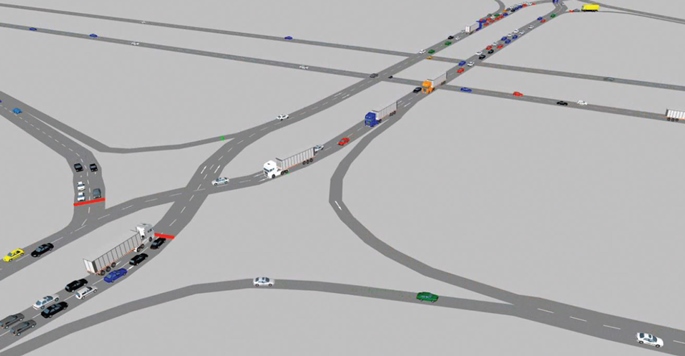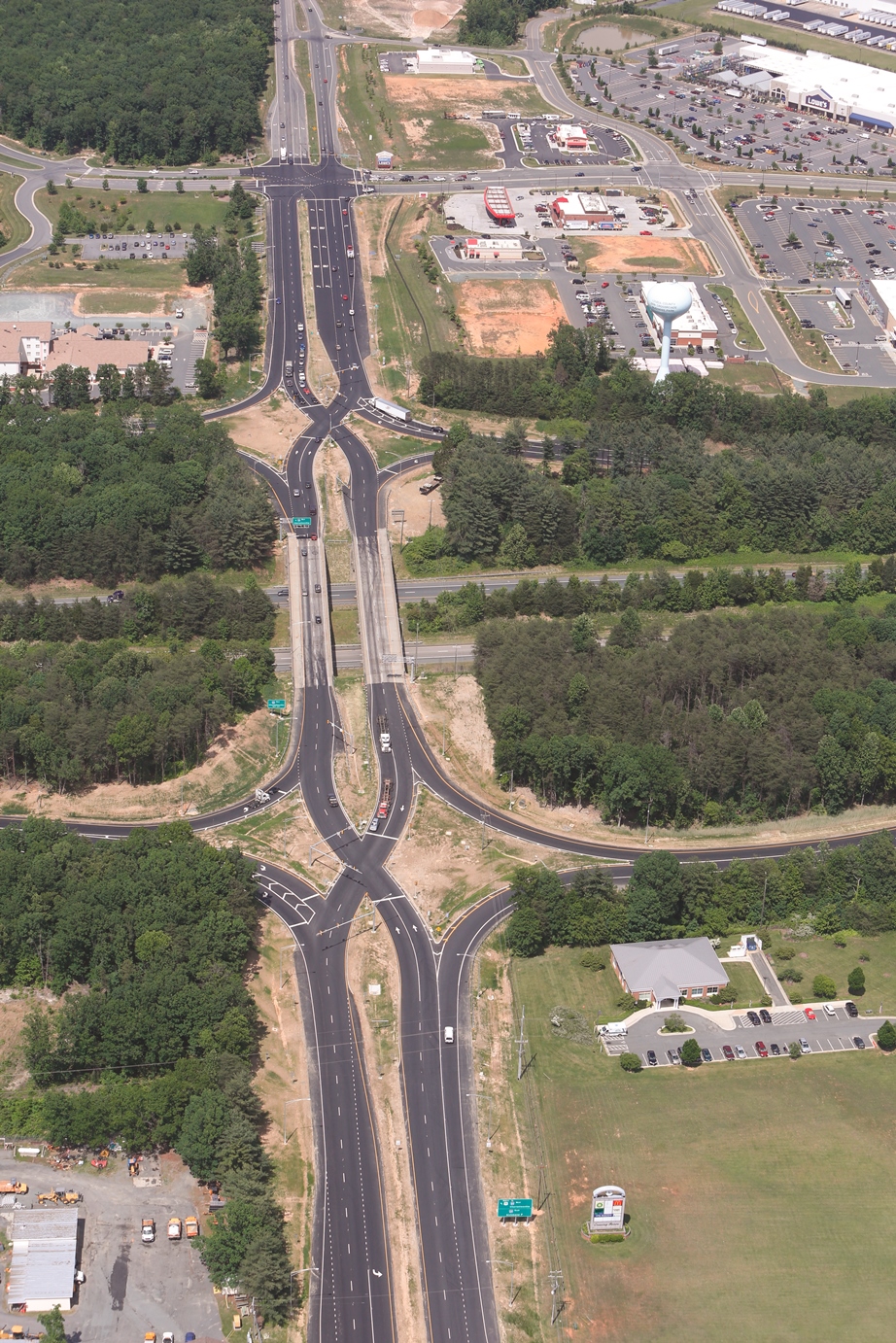Issue 1 of 2016
Diverging diamond interchanges and design-build are both innovative solutions to modern day problems. Perhaps this explains why they are so often used in conjunction.
We’ve all been there, whether you work in transportation project delivery or not, we’ve all been stuck in that traffic jam that comes in the same spot, at the same time, every day. Not caused by an accident or bad driving, these traffic jams are systemic, impacting productivity for both personal and commercial drivers. But perhaps you’ve also been at a very different interchange, not where traffic is necessarily stopping your commute, but where your drive transitions from a comfortable stroll to a mix of cars and confusion. Making these kinds of quick decisions with little understanding of where exactly the road is taking you can be just as uncomfortable as the morning traffic jam.
Have you heard? IQ now comes digital!
View this article in the digital version of our magazine by clicking here!
Finding the ultimate driver satisfaction is often somewhere in between the most clever design and the basic exit ramp. However, innovative designs are often deemed unworkable by the poor prospect of driver familiarity. For example, although it has been proposed often, driver familiarity concerns have kept exit ramps on the right side of the highway for as long as highways have been built. Of course, all of this comes at a price, and interchanges are like any other public construction project in that cost is an important component. Taken together, the challenge of devising an efficient interchange is no short order.
 Enter the diverging diamond interchange (DDI). Originally designed for the streets of Versailles, France, the DDI interchange did not get their start in America until around the year 2009. The interchange is designed to allow two directions of traffic to temporarily cross to the opposite side of the roadway in order to provide easier access on and off the freeway. In other words, four lanes of traffic still cross one another, but instead of staying parallel to one another, the road lanes passing over the freeway switch sides and then return to their normal sides once over the freeway.
Enter the diverging diamond interchange (DDI). Originally designed for the streets of Versailles, France, the DDI interchange did not get their start in America until around the year 2009. The interchange is designed to allow two directions of traffic to temporarily cross to the opposite side of the roadway in order to provide easier access on and off the freeway. In other words, four lanes of traffic still cross one another, but instead of staying parallel to one another, the road lanes passing over the freeway switch sides and then return to their normal sides once over the freeway.
The design was manifested in a 2015 Design-Build Project/Team Award winning project at the I-64/Route 15 (Zion Crossroads) Interchange in Virginia. The design-build team enhanced the original RFP concept design by eliminating “trap” lanes on Route 15 for traffic exiting from I-64 off ramps. Had the design-build team not eliminated them, “trap” lanes would have resulted in an additional weave that would have caused trouble for heavy trucks.
According to the Alternative Delivery Project Director for the Virginia Department of Transportation (VDOT), Shailendra Patel, P.E., DBIA, the need for an alternative concept to the traditional interchange arose from a forecast for an increase in traffic related to local development of a Wal-Mart and other stores. “We were interested because the DDI could salvage the bridges. And even still, there was an improvement in the efficiency and operations, even with the 2035 traffic projection.”
The design-build team enacted a solid public outreach effort that included community meetings, video simulation and educational brochures. The challenge came in the transition from the existing traffic pattern into the DDI pattern. According to Design-Build Project Manager, Jo Ellen Sines of Corman Construction, this was accomplished through a step-by-step rehearsed plan that was carried out without a hitch.
The DDI eliminated left turns across traffic (or conflict points) from the exit ramp and as a result reduced the number of spots where vehicles could collide. This is the  factor that Patel indicated as key to the interchange’s efficiency. “The conflict points are removed, which makes the DDI safer.” The DDI can handle more than 600 left turns per hour; twice the capacity of a conventional interchange, aiding traffic flow and reducing safety concerns.
factor that Patel indicated as key to the interchange’s efficiency. “The conflict points are removed, which makes the DDI safer.” The DDI can handle more than 600 left turns per hour; twice the capacity of a conventional interchange, aiding traffic flow and reducing safety concerns.
The Zion Crossroads project’s success should be no surprise in light of the accolades that this design has received in research. The Federal Highway Administration (FHWA) conducted a simulator study of the diverging diamond interchange to determine if drivers could navigate the interchange correctly in their first experience or if they would follow their habits instead of the road markings.
What the FHWA found was that DDI interchanges were not only more efficient than the traditional interchange, but that if you were in an accident while in a DDI, you would probably be safer. While both navigation errors and red-light violations slightly decreased, the DDI was much safer because drivers, on average, drove 11.2 miles per hour slower. Therefore, when considering driver behavior and design effectiveness together, FHWA concluded that, “properly designed DDIs will prove to be considerably safer than properly designed conventional diamond interchanges.”
When it comes to the delivery of these interchanges, diverging diamonds experience common challenges, as exemplified by the Zion Crossroads project, that make them well-suited for design-build. With DDI experience lacking and design standards not yet familiarized, VDOT had to rely on extensive collaboration with the design-build team led by Corman Construction, and even included a requirement in the RFP for engineers with experience in delivering these interchanges (they got Parsons Transportation Group and Wallace, Montgomery & Associates). According to Patel, once VDOT brought on the design-build team, “we now had a team with experience that could improve our original study and plan. As a result, our concept was refined and not only saved us money but it resulted in a safe and reliable interchange.” In the end, the total cost of the project dropped from an anticipated $20 to $30 million to just $6.9 million.
Providing benefits to Virginia taxpayers and drivers alike, the Zion Crossroads Interchange was completed on schedule and opened to traffic on February 21, 2014. The project dramatically improved traffic operations and safety at minimal cost and impact to local businesses and the traveling public. And even more importantly, the public loves it. “I think at first the public and the county was skeptical,” Patel said. “But now, having driven through it, they’ve become our spokespeople for it.” Design-build and the DDI have continued to be a partner for VDOT and have been used in conjunction on two additional projects that resulted in cost savings of over $20.3 million. With so many positive outcomes, it is not hard to believe that the diverging diamond interchange and design-build will make strong partners for many years to come.
